- BRACED (or BRASED)
- See ‘interlaced’.
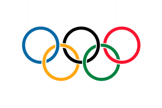
Flag of the International Olympic Committee (fotw)
- BRACELET
- See ‘barrulet’.

- BRAG FLAGS
- In largely US usage, the colloquial term for a collection of local flags,
often (but not invariably) unofficial flags, that has been amassed by the owners
of pleasure vessels to indicate the number of ports visited – a type of
souvenir flag.
- BRANCH OF SERVICE FLAG
- 1) Generically, one of those flags pertaining to a particular branch within the armed services
- an air force flag, army flag, navy flag, flag of the marine corps or similar
(see also ‘armed services flag’).
- 2) Specifically in US military usage, as above but the term may also include the flags of each
specialization within a particular branch – for example the flag of the Engineering Corps.
![[branch of service flags]](../images/v/vxt-d048.gif)
![[branch of service flags]](../images/v/vxt-d048a.gif)
![[branch of service flags]](../images/v/vxt-d048b.gif)
![[branch of service flags]](../images/v/vxt-d048c.gif)
![[branch of service flags]](../images/v/vxt-d048d.gif)
From left: Air Force Flag, RSA (fotw);
Army Flag, UK (fotw); Navy Flag, US (fotw); Flag of the
Royal Marines, UK (fotw); Flag of the
Engineering Corps, US (fotw)
- BREADTH
- 1) Generically see ‘width’.
- 2) Specifically in now largely obsolete British Royal Navy usage, a term for indicating
the width of flags. The term is derived from the width of bunting formerly employed
in manufacture, with the width of flags being expressed as a multiple of the number
of breadths used (see also ‘bunting 2’).
Please note with regard to 2) that the width of a breadth was recorded
as being 11” (27.94cm) in 1687, but had shrunk to its present size of 9” (22.84
cm) by the end of the 18th. century.
- BREAK A FLAG (BREAK OUT A FLAG or BREAKING)
- (v) To unfurl a flag that has been hoisted folded and rolled up in such a
manner that a sharp tug at the halyard will cause it to fly free (see also
‘furl’
and ‘halyard’).
Please note the above is often used to mark the beginning of an event or the arrival of a VIP.
- BRITISH-STYLE ENSIGN
- See ‘blue ensign 2)’,
‘canton flag’,
‘red ensign 2)’ and
‘white ensign 2)’
(also ‘ensign’).

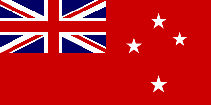
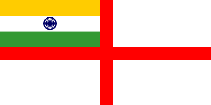
Government Ensign of Malaysia (fotw): Civil Ensign of New Zealand (fotw); Naval Ensign of India 1950 - 2001 (fotw)
- BRITISH COLOUR CODES (BRITISH COLOUR COUNCIL REFERENCE CODE or BCC)
- A now largely obsolete standard numeral colour code for cloth and flags established by Britain,
and first published in 1934 (see also ‘Pantone Matching System’).
- BRITISH (or BRITAIN) FLAG
- The original name for the 1606 pattern British union flag the Britain flag or flag of Britain - but see
‘His Majesty’s Jack’ (also
‘interlaced’,
‘James Union’ and
‘union jack’).
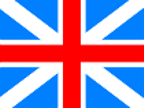
Union Flag 1601 – 1801, UK (CS)
-
Please note, evidence suggests that the terms
British and Britain flag or flag of Britain ceased in official use after 1639.
- BROAD COMMAND PENNANT
- In US naval usage now increasingly (if not entirely) obsolete, a pennant that
is flown at the main masthead in place of the commission (or
masthead) pennant to indicate the presence on board of an officer commanding a force, group or squadron
of vessels (or carrier air wing), and who has authority over any officer flying a burgee command pennant,
but who has not reached flag rank – see
‘burgee command pennant’ (also
‘broad pennant 1)’ with its following note,
‘command pennant’,
‘flag officer 1)’ and
‘masthead pennant’).
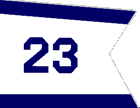
Broad Command Pennant, US (sea flags)
Please note however, that the US practice of displacing the commission (or masthead) pennant by the
burgee or the broad command pennants differs from general naval practice where the various command
pennants (excepting the broad pennant) are usually (but not invariably) flown in addition and subordinate
to the masthead pennant.
- BROAD PENNANT (or PENDANT)
- 1) Generically, a shorter and broader form of the masthead pennant, the
fly of which is cut into a swallowtail – a triangular or tapered swallowtail.
- 2) Specifically in British RN and some other usage, a pennant as in 1)
above that is flown at the main masthead in place of the commissioning (or
masthead) pennant to indicate the presence on board of an officer with the
rank of Commodore (see also
‘broad command pennant’,
‘burgee command pennant’,
‘flag of command’ and
‘masthead pennant 1)’).
- 3) In civil maritime usage, as 1) above (and often patterned after the
relevant club burgee), a broad pennant is sometimes flown by the commodore and
vice-commodore of
a yacht or boating club - an officers, flag officer or yacht officer's broad pennant
- but see ‘officer’s flags’ and
‘officer’s pennants’
(also ‘burgee’,
‘deface’ and ).
- 4) As 1) above, but sometimes with rounded points (or a lanceolate fly)
and flown from the main masthead to mark the presence aboard ship of a head of
state or a member of an royal/imperial family - an imperial, royal, or kings broad
pennant and others (see also ‘lanceolate’
and royal masthead pennant).
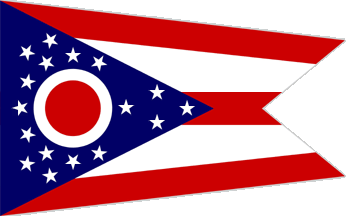
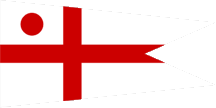
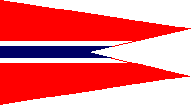
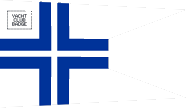
Flag of Ohio, US (fotw);
Commodore’s Broad Pennant, UK (fotw); Commodore’s Broad Pennant, Norway (fotw);
Yacht Club Commodore’s Broad Pennant, Finland (fotw)

Kings Broad Pennant, Thailand (fotw)
Please note, that in the US Navy and some others the rank of commodore
- to which the broad pennant belongs - has been superseded by that of rear admiral
(lower half) and the pennant accordingly replaced by an appropriate flag of command
(see also ‘broad command pennant’,
‘flag of command 1)’ and
‘in abeyance’).

Former Commodore’s Broad Pennant, US (seaflags)
- BROD
- A Scottish term, now obsolete, for a flag hanging from a crossbar – a gonfalon
(see ‘gonfalon’).
- BROKEN CROSS
- See ‘swastika’
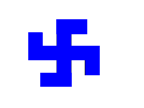
House Flag of The Iceland Steamship Co Ltd 1914 c1943 (fotw)
- BRUNATRE
- A heraldic term for the colour brown (see also ‘Appendix III’
and ‘rule of tincture’).
![[colour example]](../images/v/vxt-d555c.gif)
- BUDGEE JACK
- See ‘privateer jack’, and for background on the term see also
‘budgee flag’ and
‘budgee pendant’ below.
![[budgee jack]](../images/v/vxt-d1030.gif)
Budgee/Privateer Jack until 1801. UK
- BUDGEE FLAG
- A late 17th, early 18th Century English/UK naval term, now obsolete, for an
ensign that bore a union flag canton rather than a canton with the cross of St
George, and before 1707 for use only outside home waters (see also
‘budgee pendant’, ‘privateer jack’ and
‘ensign 1)’).
![[budgee flag]](../images/v/vxt-d052.gif)
English Red Ensign c1625 – 1707 Budgee Flag for
use outside home waters until 1707, then British Red Ensign 1707 – 1801 (CS)
Please note that prior to 1707, as far as can be discovered, the budgee flag was invariably a red ensign
see red ensign 2).
- BUDGEE PENDANT (or PENNANT)
- A late 17th, early 18th Century English/UK naval term, now obsolete, for a
red swallow-tailed pennant which bore a union flag rather than the cross of St
George at its hoist for use as a pennant of distinction by senior captains in
command of a formation of ships outside home waters – a union pendant (see also
‘broad pennant’,
‘budgee flag’,
‘pendant’,
‘pendant of distinction’,
‘privateer jack’,
‘union jack’ and
‘union mark’).
![[budgee pendant]](../images/v/vxt-d054.gif)
The Budgee Pendant c1700, UK (CS)
Notes
a) As far as is known the budgee pendant
had disappeared by 1710
b) The Editors – whilst no firm evidence could be
found have taken the colour of the pendant’s fly from that of the standard
distinction pennant as introduced in 1674.
- BUDDHIST FLAG
- A flag with a number of variations symbolizing Buddhism, most often (but not
invariably) showing five vertical and five horizontal stripes and first raised in 1885
(see also chakra,
prayer flag,
religious flag and
thangka).

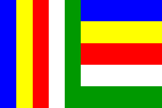
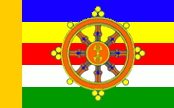

"Standard" Buddhist Flag (fotw); as used in
Burma, Tibet and
Thailand (fotw and Corentin Chamboredon)
- BUFF
- In largely (but not exclusively) US usage, a term for that shade of beige, which corresponds
to uniform facings worn during the American War of Independence by some general officers and
by many line regiments of the Continental infantry.

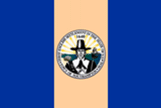
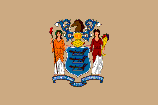
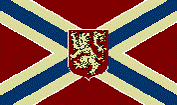
Uniform of 1776: Flag of Southampton, New York, US (fotw); Flag of
New Jersey, US (fotw); Flag of
Winchester, Virginia, US (fotw);
Notes
a) Buff was also one of the facing colours used by the British army at the time of the American War of Independence see facing colour.
b) It is suggested that use of the facings mentioned
above could have derived from the buff-coloured (leather) coats worn by both infantry and
cavalry in the 17th Century.
- BUILDING SITE FLAG (or BSF)
- See ‘logo on a bed sheet’.
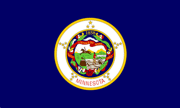
Flag of the State of Minnesota, US (fotw)
- BULLOCK PENNANT
- In 18th Century French naval usage the term, now obsolete, for a red pennant
hoisted from the flagship to signal that a ration bullock had just been slaughtered
(see also ‘beef pennant’,
‘flagship’ and
‘pennant 2)’).
Please note, information suggests that this term -
a direct translation of the French "flamme de boeuf" - may have ceased after 1792,
however, this is not certain and no equivalent signal can be found in contemporary
British naval sources. Nonetheless supply vessels carrying beef to the Royal Navy
are known to have flown a blue flag bearing a white bullock in the late 19th Century.
- BUNTINE
- An alternative spelling, now largely obsolete, of bunting see bunting 1).
- BUNTING
- 1) Strong, loosely woven cloth used for making flags, originally of cotton
and/or wool but sometimes of other fibres, and now largely replaced by synthetic
materials materials buntine, bewper or beaufort.
- 2) A series of small, simple flags connected by a line, or a length of gathered
decorative fabric, generally in the national colours and usually hung or draped
between two anchor points. Often employed when flag usage would be inappropriate
or unsuitable (see also ‘fan’,
mourning bunting,
‘national colours’ and
‘rules of respect’).
- 3) In heraldry a species of bird as a charge.
![[bunting]](../images/v/vxt-d056.gif)
![[bunting]](../images/v/vxt-d056a.gif)
- BUNTING TOSSER (or BUNTS)
- In British Royal Navy usage and some others, a traditional nickname for those sailors
in the signals branch whose duties include the care and hoisting of signal flags, flags
of command and ensigns etc. - but see ‘flags 1)’
(also ‘command pennant’,
‘flag locker’,
‘flag of command’,
‘flags 1)’,
‘naval ensign’ under ‘ensign’,
‘signal flag’and
‘yeoman of signals’).
- BURGEE
- 1) The small distinguishing flag of a yacht or boating club, usually (but
not exclusively) either triangular or in the shape of a tapered swallowtail (see
also ‘broad pennant 3)’,
‘officer’s pennants’,
‘swallow-tail(ed)’ and
‘souvenir flags’).
- 2) In obsolete naval usage, a term sometimes applied to the swallow-tailed
pennants used in flag signalling but see burgee command pennant (also
‘international code of signals’,
‘pennant 2)’,
‘signal flag’ and
‘swallow-tail(ed)’).
![[burgees]](../images/v/vxt-d058.gif)
![[burgees]](../images/v/vxt-d1830.gif)
![[burgees]](../images/v/vxt-d2058.gif)
![[burgees]](../images/v/vxt-d058a.gif)
From lef: Encinal Yacht Club USA (fotw);
Royal Lymington Yacht Club
UK (Bartram); Burin Sailing Club, Croatia (fotw); Knysna Yacht Club RSA (fotw)
Please note, it is suggested by some sources that
the term derives from ‘budgee’ which it is proposed was an alternative 17th Century
name for bunting (see also ‘budgee flag’ and
‘budgee pendant’).
- BURGEE COMMAND PENNANT
- In US naval usage, a pennant that is flown at the main masthead in place of
the commission (or masthead) pennant to indicate the presence on board of an officer
in command of a formation of vessels (or an aircraft wing), but who holds the
rank of captain or lower - see ‘broad command pennant’
(also ‘broad pennant’,
‘burgee 2)’,
‘burgee command pennant’, command pennant’,
‘flag of command’,
‘masthead pennant 1)’ and
‘private ship’).
![[burgee command pennant]](../images/v/vxt-d060.gif)
Burgee Command Pennant, US (CS)
Please note however, that the US practice of displacing
the commission (or masthead) pennant by the burgee or the broad command pennants
differs from general naval practice where the various command pennants (excepting
the broad pennant) are usually (but not invariably) flown in addition and subordinate
to the masthead pennant.
- BURGUNDY CROSS
- See ragged cross.
![[burgundy cross]](../images/v/vxt-d1681.gif)
Flag of The Carlists, Spain (fotw)
- BURIAL FLAG
- See ‘pall flag’.
-
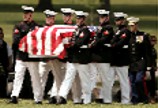
(adamtglass.com)
- BURNING
- In heraldry see ‘flamant’ (also ‘inflamed (also ‘incensed’).
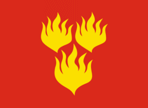

Flag and Arms of Karasjok, Norway (fotw & Tomislav ipek)
- BUSS
- (v) In Scottish usage a term to describe the decoration of a finial with
coloured ribbons.

![[branch of service flags]](../images/v/vxt-d048.gif)
![[branch of service flags]](../images/v/vxt-d048a.gif)
![[branch of service flags]](../images/v/vxt-d048b.gif)
![[branch of service flags]](../images/v/vxt-d048c.gif)
![[branch of service flags]](../images/v/vxt-d048d.gif)











![[budgee flag]](../images/v/vxt-d052.gif)
![[budgee pendant]](../images/v/vxt-d054.gif)









![[burgees]](../images/v/vxt-d058.gif)
![[burgees]](../images/v/vxt-d1830.gif)
![[burgees]](../images/v/vxt-d2058.gif)
![[burgees]](../images/v/vxt-d058a.gif)
![[burgee command pennant]](../images/v/vxt-d060.gif)
![[burgundy cross]](../images/v/vxt-d1681.gif)





![[colour example]](../images/v/vxt-d555c.gif)
![[budgee jack]](../images/v/vxt-d1030.gif)
![[bunting]](../images/v/vxt-d056.gif)
![[bunting]](../images/v/vxt-d056a.gif)
